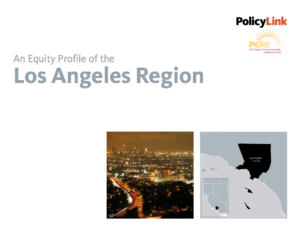 An Equity Profile of the Los Angeles Region
An Equity Profile of the Los Angeles Region
PolicyLink and USC Program for Environmental & Regional Equity
First published August 2017
While the nation is projected to become a people-of-color majority by the year 2044, Los Angeles reached that milestone in the 1980s. Since 1980, Los Angeles has experienced dramatic demographic growth and transformation—driven, in part, by an influx of immigrants from Latin American and Asia. Today, demographic shifts—including immigration trends—have slowed.
Los Angeles’ diversity is a major asset in the global economy, but inequities and disparities are holding the region back. Los Angeles is the seventh most unequal among the largest 150 metro regions. Since 1990, poverty and working poverty rates in the region have been consistently higher than the national averages. Racial and gender wage gaps persist in the labor market. Closing racial gaps in economic opportunity and outcomes will be key to the region’s future.
To build a more equitable Los Angeles, leaders in the private, public, nonprofit, and philanthropic sectors must commit to putting all residents on the path to economic security through equity-focused strategies and policies to grow good jobs, build capabilities, remove barriers, and expand opportunities for the people and places being left behind.
Download Resource